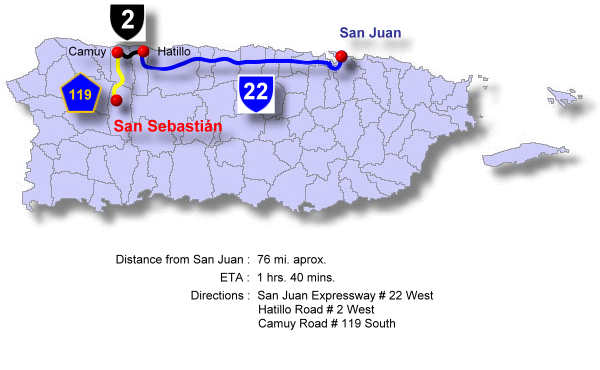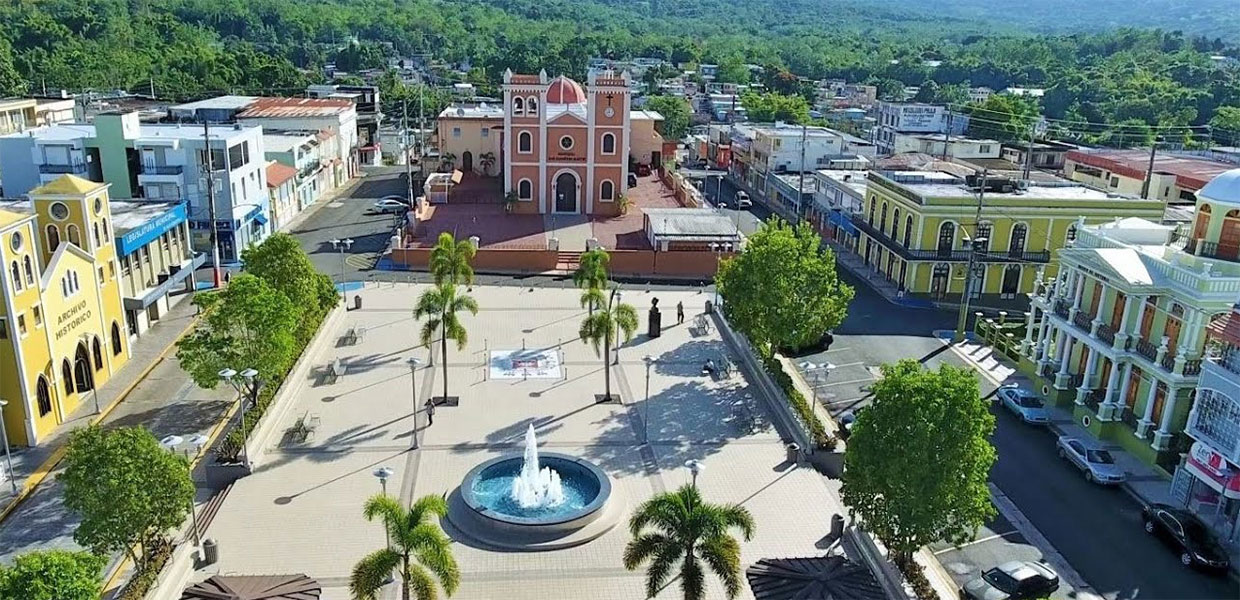
San Sebastián, Puerto Rico
St. Sebastián Del Pepino
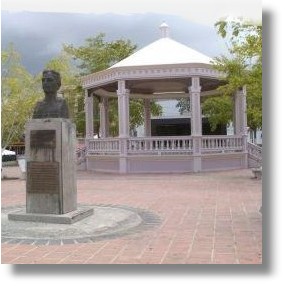
San Sebastián (sahn se-bahs-tee-AHN) most widely nicknamed “San Sebastián del Pepino”, are also called “the hammock town”. The townspeople are known as pepinianos and patrulleros (patrollers). The patron saint is Saint Sebastian, the Martyr.
San Sebastián is located in the central mountain range of Puerto Rico. Is bordered on the north by Isabela and Quebradillas, on the east by Lares, on the south by Las Marías, and on the west by Moca and Añasco.
The town lies in the geographical region of the humid northern hills. The mountainous topography includes elevations between 100 and 300 meters (330 to 985 feet) above sea level.
The economy of the municipality is based on coffee and produce, as well as the cattle and dairy industries. There is some manufacturing, including needlework.
Foundation:
The original name was San Sebastian, de las Vegas y el Pepino, because of its location in an extensive valley protected by mountains, watered by the Culebrinas and Guatemala rivers, and by the locally wooded hills called "pepinos" (cucumbers), characteristic of the karst zone.
Authorization to found the town dates from 1752. It is said that its founder was don Cristóbal González, neighbor of the area. After seven years (1759) the construction of the first parish was culminated and placed under the patronage of San Sebastián Mártir. Later in 1808 and 1812 the House of the King and the City Council were built, respectively.
During the first years of its foundation, after exploiting the forests and ruining the forest wealth, the economy was mainly based on cattle and equine raising, sugar cane, coffee, cotton, tobacco, rice and fruits were also cultivated.
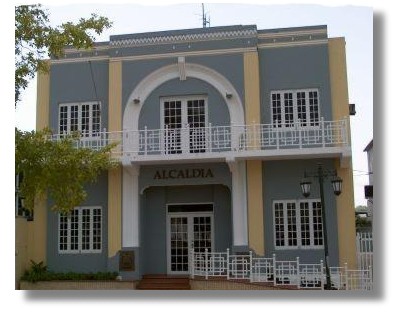
In the 1815 numerous immigrants arrived to Pepino who introduced capital and slave manual labor, that stimulated the economic development. One decade later Pepino counted on 53 wooden sugar refineries, 4 stills that processed sugar cane melases, and the produced coffee, cotton and fruits.
In 1823 the first primary school of the town was founded and in 1828 the population had already exceeded 9,000 inhabitants. Eighteen years later Pepino counted with more than 100 homes, two primary schools and the municipal population exceeded 10,000 inhabitants.
In 1868 the historical episode known as the "Grito de Lares", (Lares Revolt) took place. One of the more important Revolutionary Groups in the organization of the revolt was the "Porvenir" of Pepino, whose most outstanding members were Manuel Cebollero, Eusebio Ibarra, Cristóbal Castro, Cesáreo Martínez, Clodomiro Abril and Francisco José Méndez. The facts, which correspond to the History of Puerto Rico, consisted of the taking of Lares and the frustrated attack against Pepino.
In 1869 the Government authorized the name of Pepino be changed to San Sebastian.
In 1919, like a inheritance of its past, the following public buildings existed in San Sebastián: The House of the King, slaughter house, meat market, the Municipal and Lunatic hospitals, the cemetery chapel and the Municipal Public square.
Location:
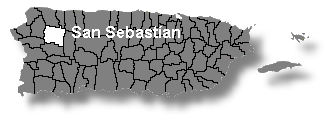 It borders with Isabela and Quebradillas to the north, south with Las Marías, west with Moca and Ańasco and east with Lares.
It borders with Isabela and Quebradillas to the north, south with Las Marías, west with Moca and Ańasco and east with Lares.
Area:
137.8 sq km / 53.0 sq mi
Population:
44,204 (census 2000)
Population Density:
320.7 per sq km / 834.0 per sq mi
People are known as:
Pepinianos
San Sebastián is also known as:
San Sebastián Del Pepino
Los Pepinianos
Cuna de la Hamaca
Los Patrulleros
Wards: San Sebastian, Puerto Rico
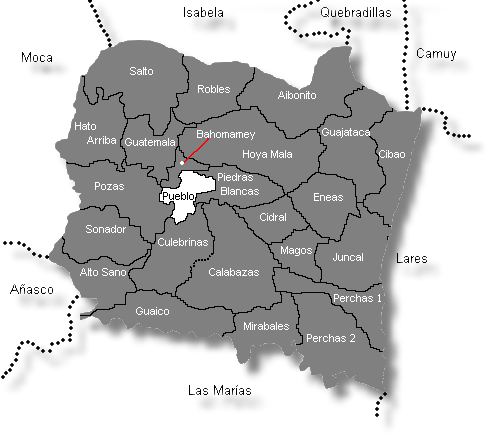
| Census 2000: Population by Wards - San Sebastián |
Habitants |
| Aibonito | 2,116 |
| Alto Sano | 1,282 |
| Bahomamey | 2,740 |
| Calabazas | 2,458 |
| Cibao | 1,218 |
| Cidral | 453 |
| Culebrinas | 4,006 |
| Eneas | 912 |
| Guacio | 733 |
| Guajataca | 700 |
| Guatemala | 2,919 |
| Hato Arriba | 1,991 |
| Hoya Mala | 3,505 |
| Juncal | 2,075 |
| Magos | 242 |
| Mirabales | 624 |
| Perchas 1 | 1,024 |
| Perchas 2 | 1,072 |
| Piedras Blancas | 2,562 |
| Pozas | 3,713 |
| Robles | 1,595 |
| Salto | 2,887 |
| San Sebastián Pueblo | 1,952 |
| Sonador | 1,425 |
| Total | 44,204 |
Información: Negociado del Censo de los EE.UU. Censo 2000
Patron:
San Sebastián Mártir
Parroquia San Sebastián Martir
Apartado 801
San Sebastián, P.R. 00685
(787) 896-1028
Mass Schedule:
Monday thru Friday: 7:00am & 6:15pm
Saturday: 6:15pm
Sunday: 7:00am, 8:15am, 9:30am, 10:30am & 6:15pm
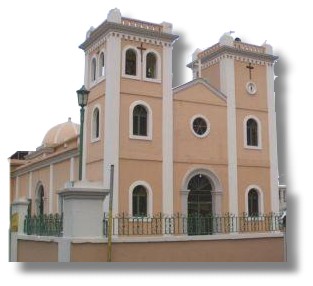
Topography:
It is located in the Interior Central Mountains. In general, its terrain is slightly elevated although it counts with numerous small elevations or wooded hills, known as "pepinos", from where the name of San Sebastián Del Pepino comes from.
Hydrography:
It is watered by the Grande de Ańasco, Culebrinas, Guajataca rivers, several affluents and the dam known as the Guajataca Lake.
Economy:
Agriculture (cattle and sugar cane).
Average Salary:
$ 249.01 weekly (1998)
Flag:
 It consists of a rectangular flag of the usual proportions, crossed by a white waved band that separates its red superior part from the inferior one, that is green. The red color symbolizes the patron San Sebastián Mártir and the revolt of September 24, 1868, where the town witnessed the bloody events originated by the Revolutionary Movement of Lares; the color green represents the mountains of Pepino; and the white waved band, the Culebrinas River.
It consists of a rectangular flag of the usual proportions, crossed by a white waved band that separates its red superior part from the inferior one, that is green. The red color symbolizes the patron San Sebastián Mártir and the revolt of September 24, 1868, where the town witnessed the bloody events originated by the Revolutionary Movement of Lares; the color green represents the mountains of Pepino; and the white waved band, the Culebrinas River.
Coat Of Arms:
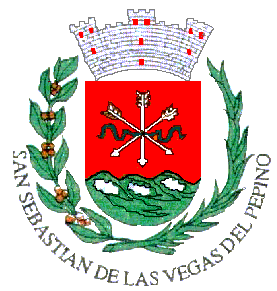 The three arrows represent Patron Saint of the population, San Sebastian Mártir, officially named in 1869. The arrows constitute the attribute of this Saint. According to tradition he was killed with arrows by his pursuers, giving this way testimony of faith. The arrows that appear in the old seal of the population perpetuate the use of its symbolism. The red color of the shield has in addition another symbolism; the faith of the martyr. It recalls that San Sebastián was the first town of Puerto Rico in the course of a combat operation, blood for the national freedom of Puerto Rico was spilled. It was in effect, in the plaza of the town, next to the Parochial Church, on September 24, 1868, where by the gun fire of loyal milicianos of the Spanish regime, Venancio Roman fell along with other patriotics of Lares who came to occupy the military quarters of Pepino.
The three arrows represent Patron Saint of the population, San Sebastian Mártir, officially named in 1869. The arrows constitute the attribute of this Saint. According to tradition he was killed with arrows by his pursuers, giving this way testimony of faith. The arrows that appear in the old seal of the population perpetuate the use of its symbolism. The red color of the shield has in addition another symbolism; the faith of the martyr. It recalls that San Sebastián was the first town of Puerto Rico in the course of a combat operation, blood for the national freedom of Puerto Rico was spilled. It was in effect, in the plaza of the town, next to the Parochial Church, on September 24, 1868, where by the gun fire of loyal milicianos of the Spanish regime, Venancio Roman fell along with other patriotics of Lares who came to occupy the military quarters of Pepino.
- The Mountains: With silverplated borders, represent the characteristic mountains (Pepinos) that dominate the area from which it derives its name.
- The Crown: Is the heraldic standard used to identify towns, villas and cities. It symbolizes the defense and conservation of the municipal traditions and the union of intentions that must reign between the inhabitants of a municipality.
- The Sugar Cane and Coffee Branches: They represent main agricultural products of the zone where the population is based.
Events:
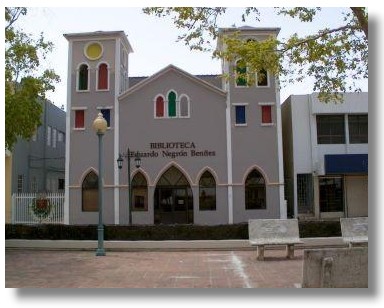
- Three Kings Day Festival – January
- Children`s Festival – January
- Patron Saint`s Festival – January
- Heifer`s Festival – January (first Sunday during the patron saint`s festival)
- Hammock Festival – July
- Lighting of the Christmas tree – November
- Cultural evenings – third Thursday of the month
- Farmer`s Market – every Friday
Places To Visit:
- Camp Guajataca
- City Hall
- Doña Visa residence
- Robles or Paraíso Perdido falls
- Luis Rodríguez Cabrero Cultural Center
- Mount Del Sombrero
- Sculpture of a heifer
- El Jibarito Plantation
- Lake Guajataca
- Saint Sebastian the Martyr Parish
- September 24 Promenade
- Marketplace
- Román Baldorioty de Castro Square
- Guajataca Reserve
- Central Plata ruins
- Collazo falls
- Benito Fred Theater
Distinguished Citizens:
- Juan F. Acosta Arce – composer and musician.
- Salvador Arana Soto – historian, physician, essayist, and short-story writer.
- Margarita Castro Alberty – renowned soprano. Castro has sung at the Metropolitan Opera in New York.
- ángel Mislán Huertas – virtuoso of the euphonium and notable composer.
- Rafael Seguí Barrero – composer, poet, and reciter.
- Sinforoso Vélez Arocho – the first Puerto Rican soldier to participate in the First World War.
- Nilita Vientós Gastón – an attorney at the Department of Justice in San Juan. President of the Puerto Rico Atheneum (1946 – 1961). Director of the literary magazine Asomante and founder of the literary magazine Sin nombre. Advocate of the Spanish language.
Public Schools sorted by educational levels.
San Sebastian District
| Name | Level | Telephone | Address |
| AGUSTÍN ACEVEDO HERNÁNDEZ | Elementary | (787) 896-2105 | PO Box 4704 |
| AIBONITO BELTRÁN | Elementary | (787) 896-4362 | PO Box 977 |
| ÁNGEL GUERRERO LUGO | Elementary | (787) 896-2888 | PO Box 4704 |
| ÁUREA FUENTES MÉNDEZ | Elementary | (787) 896-4100 | PO Box 5220 |
| FRANCISCO LUGO ROSA | Elementary | (787) 280-0863 | HC-05 Box 42005 |
| GUILLERMO CARDE | Elementary | (787) 896-0199 | PO Box 1220 |
| INÉS MENDOZA | Elementary | (787) 280-1863 | PO Box 4704 |
| JOAQUÍN ORONOZ RODÓN | Elementary | (787) 896-1775 1680 | Ave. Emerito Estrada |
| JUAN CARDONA RODRÍGUEZ | Elementary | (787) 896-1425 | PO Box 4644 |
| JUANA B. GUZMÁN | Elementary | (787) 280-4072 | PO Box 662 |
| JULIO CANCEL (ANEXO) | Elementary | (787) 896-0115 | PO Box 1220 |
| JULIO CANCEL FACUNDO | Elementary | (787) 896-1072 | PO Box 1220 |
| MARÍA S. DEL RÍO | Elementary | (787) 896-0166 | Bo. Robles Carr. # 466 km 3 hm |
| MINIMA ORONOZ | Elementary | (787) 896-4669 | PO Box 7000 Suite 70 |
| PABLO CARDONA | Elementary | (787) 896-5940 | PO Box 4704 |
| PERCHAS RABEL I. | Elementary | (787) 896-6492 | PO Box 4704 |
| RAMÓN M TORRES | Elementary | (787) 896-1135 | PO Box 5443 |
| ERNESTINA MÉNDEZ | Intermediate | (787) 896-1745 | Suite 138 |
| NARCISO RABELL CABRERO | Intermediate | (787) 896-1164 | PO Box 1619 |
| PERCHAS ROSARIO | Intermediate | (787) 896-4497 | PO Box 4704 |
| EMILIO SCHARON RODRÍGUEZ | Secondary | (787) 896-4142 | PO Box 4691 |
| BERNARDO MÉNDEZ JIMÉNEZ | SSecondary | (787) 896-5980 | PO Box 1676 |
| CARMELO SERRANO CUBANO | Secondary | (787) 896-6810 | PO Box 1676 |
| MAXIMINO A. SALAS | Secondary | (787) 896-2838 | PO Box 2855 |
| NUEVA SUPERIOR VOCACIONAL | High School | (787) 896-1430 | PO Box 1277 |
| PATRIA LATORRE | High School | (787) 896-3970 | PO Box 5379 |
Hymn:
Lirics: Juan Avilés Medina
Music: Guillermo Figueroa
Van más de dos siglos de historia de vida,
vida con historia, siempre Florecida
de esperanzas nuevas, de anhelo y de afán,
con el gran prodigio de la Fe Cristiana
que abrió los caminos de ayer al mañana
bajo el nombre Augusto de San Sebastián.
Somos de los llanos, somos de la sierra,
somos de los valles, somos de la tierra
que lleva muy hondo clavada en su entraña
la feliz historia del Río Culebrinas, l
as nobles leyendas de hazañas taínas
y la historia escrita con sangre de España.
Tenemos orgullo, forjamos cultura,
labramos rencores, sentimos bravura,
guardamos amores en el corazón.
Pero en un instante, cultura y rencores,
bravura y ternura y orgullo y amores
se postran de hinojos a nuestro Patrón.
Deprisa vivimos la vida de día;
vamos al progreso con la gallardía
de un pueblo que marcha con paso seguro.
Y el Viejo Pepino de los pepinianos
sigue siendo el pueblo de miles
de hermanos que van siempre unidos.

